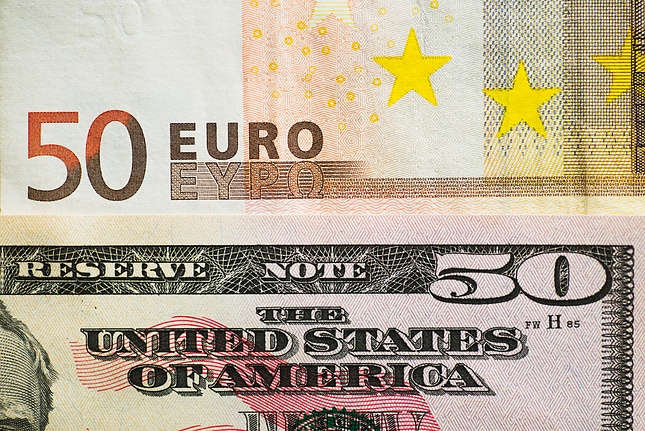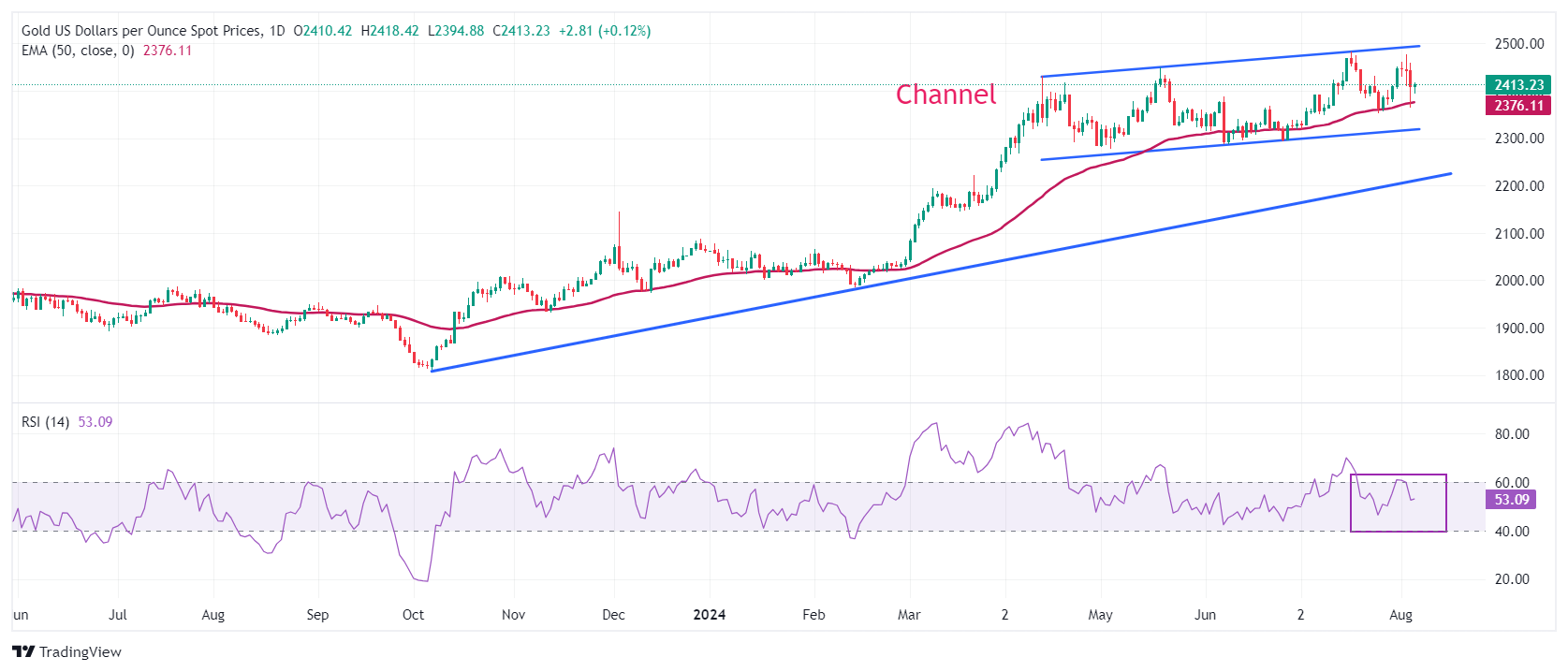- Gold price hovers below $2,400 but the near-term bias remains bullish on multiple tailwinds.
- The Fed is expected to cut interest rates by more than 100 bps this year.
- Investors worry that the US could face a recession.
Gold price (XAU/USD) struggles to hold key ground at $2,400 as the US Dollar (USD) and bond yields rise in Tuesday’s North American session. The precious metal edges lower while investors look for fresh cues, which could clarify whether the United States (US) enters a recession. Also, market participants await signals about how much the Federal Reserve (Fed) will reduce interest rates this year.
The US Dollar Index (DXY), which tracks the Greenback’s value against six major currencies, climbs to near 103.00 after recovering from more than a six-month low near 102.15. The 10-year US Treasury yields jump to near above 3.86%. Historically, higher yields on interest-bearing assets reduce the opportunity cost of non-yielding assets, such as Gold.
Meanwhile, the overall outlook of the Gold price remains firm due to multiple tailwinds. Deepening Middle East tensions have improved the Gold’s appeal as a safe-haven asset. Market participants brace for a serious escalation in conflicts between Iran and Israel as the former launched dozens of missiles on Israeli territory on Saturday in retaliation to the assassination of Hamas leader Ismail Haniyeh by an Israeli airstrike in Tehran.r
Daily digest market movers: Gold price falls slightly but near-term appeal remains firm
- Gold price remains on a positive trajectory on firm speculation that fears of a US economic slowdown will bolster bulk rate cuts by the Fed. Fears of the US facing a recession were prompted by soft labor demand, a higher Unemployment Rate, and contracting activities in the manufacturing sector.
- The signal that confirms a technical recession is two consecutive declines in the nation’s Gross Domestic Product (GDP). The US economy performed strongly in the first half of this year. In the second quarter, the economy expanded by 2.8% on an annualized basis, double the growth rate recorded in the first quarter.
- Meanwhile, a faster-than-expected expansion in the US ISM Services Purchasing Managers Index (PMI) has also diminished recession fears. Commenting on the Services PMI performance, Chris Williamson, chief business economist at S&P Global Market Intelligence said, “The July surveys are indicative of the economy continuing to grow at the start of the third quarter at a rate comparable to GDP rising at a solid annualized 2.2% pace."
- According to the CME FedWatch tool, 30-day Federal Funds futures pricing data shows traders see an imminent 50-basis point (bps) cut in interest rates in September. The data also shows that the Fed is expected to reduce its key borrowing rates by more than 100 bps this year.
- The expectations of sooner rate cuts have also been bolstered by Fed officials’ dovish outlook on interest rates. On Monday, comments from Chicago Federal Bank President Austan Goolsbee, in an interview on CNBC’s "Squawk Box" program, indicated that the central bank is prepared to respond to signs of economic weakness. Goolsbee said, “It doesn’t make sense to maintain a "restrictive" policy stance if the economy is softening,” Reuters reported.
US Dollar Price Today:
US Dollar PRICE Today
The table below shows the percentage change of US Dollar (USD) against listed major currencies today. US Dollar was the strongest against the British Pound.
| USD | EUR | GBP | JPY | CAD | AUD | NZD | CHF | |
|---|---|---|---|---|---|---|---|---|
| USD | 0.36% | 0.68% | 0.64% | 0.05% | 0.22% | 0.34% | 0.25% | |
| EUR | -0.36% | 0.35% | 0.29% | -0.32% | -0.16% | -0.09% | -0.10% | |
| GBP | -0.68% | -0.35% | -0.04% | -0.63% | -0.49% | -0.42% | -0.49% | |
| JPY | -0.64% | -0.29% | 0.04% | -0.62% | -0.43% | -0.38% | -0.27% | |
| CAD | -0.05% | 0.32% | 0.63% | 0.62% | 0.15% | 0.23% | 0.15% | |
| AUD | -0.22% | 0.16% | 0.49% | 0.43% | -0.15% | 0.08% | 0.00% | |
| NZD | -0.34% | 0.09% | 0.42% | 0.38% | -0.23% | -0.08% | -0.02% | |
| CHF | -0.25% | 0.10% | 0.49% | 0.27% | -0.15% | -0.00% | 0.02% |
The heat map shows percentage changes of major currencies against each other. The base currency is picked from the left column, while the quote currency is picked from the top row. For example, if you pick the US Dollar from the left column and move along the horizontal line to the Japanese Yen, the percentage change displayed in the box will represent USD (base)/JPY (quote).
Technical Analysis: Gold price holds key 50-day EMA
Gold price trades in a channel formation on a daily timeframe, which is slightly rising but broadly exhibited a sideways performance for more than three months. The 50-day Exponential Moving Average (EMA) near $2,370 continues to provide support to the Gold price bulls.
The 14-day Relative Strength Index (RSI) oscillates inside the 40.00-60.00 range, suggesting indecisiveness among market participants.
A fresh upside would appear if the Gold price breaks above its all-time high of $2,483.75, which will send it into unchartered territory.
On the downside, the upward-sloping trendline at $2,225, plotted from the October 6 low near $1,810.50, will be a major support in the longer term.
Fed FAQs
Monetary policy in the US is shaped by the Federal Reserve (Fed). The Fed has two mandates: to achieve price stability and foster full employment. Its primary tool to achieve these goals is by adjusting interest rates. When prices are rising too quickly and inflation is above the Fed’s 2% target, it raises interest rates, increasing borrowing costs throughout the economy. This results in a stronger US Dollar (USD) as it makes the US a more attractive place for international investors to park their money. When inflation falls below 2% or the Unemployment Rate is too high, the Fed may lower interest rates to encourage borrowing, which weighs on the Greenback.
The Federal Reserve (Fed) holds eight policy meetings a year, where the Federal Open Market Committee (FOMC) assesses economic conditions and makes monetary policy decisions. The FOMC is attended by twelve Fed officials – the seven members of the Board of Governors, the president of the Federal Reserve Bank of New York, and four of the remaining eleven regional Reserve Bank presidents, who serve one-year terms on a rotating basis.
In extreme situations, the Federal Reserve may resort to a policy named Quantitative Easing (QE). QE is the process by which the Fed substantially increases the flow of credit in a stuck financial system. It is a non-standard policy measure used during crises or when inflation is extremely low. It was the Fed’s weapon of choice during the Great Financial Crisis in 2008. It involves the Fed printing more Dollars and using them to buy high grade bonds from financial institutions. QE usually weakens the US Dollar.
Quantitative tightening (QT) is the reverse process of QE, whereby the Federal Reserve stops buying bonds from financial institutions and does not reinvest the principal from the bonds it holds maturing, to purchase new bonds. It is usually positive for the value of the US Dollar.
Information on these pages contains forward-looking statements that involve risks and uncertainties. Markets and instruments profiled on this page are for informational purposes only and should not in any way come across as a recommendation to buy or sell in these assets. You should do your own thorough research before making any investment decisions. FXStreet does not in any way guarantee that this information is free from mistakes, errors, or material misstatements. It also does not guarantee that this information is of a timely nature. Investing in Open Markets involves a great deal of risk, including the loss of all or a portion of your investment, as well as emotional distress. All risks, losses and costs associated with investing, including total loss of principal, are your responsibility. The views and opinions expressed in this article are those of the authors and do not necessarily reflect the official policy or position of FXStreet nor its advertisers. The author will not be held responsible for information that is found at the end of links posted on this page.
If not otherwise explicitly mentioned in the body of the article, at the time of writing, the author has no position in any stock mentioned in this article and no business relationship with any company mentioned. The author has not received compensation for writing this article, other than from FXStreet.
FXStreet and the author do not provide personalized recommendations. The author makes no representations as to the accuracy, completeness, or suitability of this information. FXStreet and the author will not be liable for any errors, omissions or any losses, injuries or damages arising from this information and its display or use. Errors and omissions excepted.
The author and FXStreet are not registered investment advisors and nothing in this article is intended to be investment advice.
Recommended content
Editors’ Picks

EUR/USD holds above 1.0450 after German sentiment data
EUR/USD stays in positive territory above 1.0450 after retracing a portion of its bullish opening gap. The data from Germany showed that the IFO - Current Assessment Index declined to 84.3 in November from 85.7, while the Expectations Index edged lower to 87.2 from 87.3.

GBP/USD pulls back toward 1.2550 as US Dollar sell-off pauses
GBP/USD is falling back toward 1.2550 in the European session on Monday after opening with a bullish gap at the start of a new week. A pause in the US Dollar decline alongside the US Treasury bond yields weighs down on the pair. Speeches from BoE policymakers are eyed.

Gold price manages to hold above $2,650 amid sliding US bond yields
Gold price maintains its heavily offered tone through the early European session on Monday, albeit manages to hold above the $2,650 level and defend the 100-period Simple Moving Average (SMA) on the 4-hour chart. Scott Bessent's nomination as US Treasury Secretary clears a major point of uncertainty for markets.

Bitcoin consolidates after a new all-time high of $99,500
Bitcoin remains strong above $97,700 after reaching a record high of $99,588. At the same time, Ethereum edges closer to breaking its weekly resistance, signaling potential gains. Ripple holds steady at a critical support level, hinting at continued upward momentum.

Eurozone PMI sounds the alarm about growth once more
The composite PMI dropped from 50 to 48.1, once more stressing growth concerns for the eurozone. Hard data has actually come in better than expected recently – so ahead of the December meeting, the ECB has to figure out whether this is the PMI crying wolf or whether it should take this signal seriously. We think it’s the latter.

Best Forex Brokers with Low Spreads
VERIFIED Low spreads are crucial for reducing trading costs. Explore top Forex brokers offering competitive spreads and high leverage. Compare options for EUR/USD, GBP/USD, USD/JPY, and Gold.
